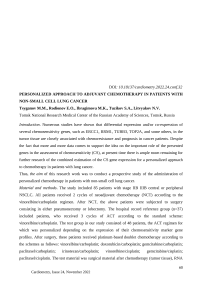Personalized approach to adjuvant chemotherapy in patients with non-small cell lung cancer
Автор: Tsyganov M.M., Rodionov E.O., Ibragimova M.K., Tuzikov S.A., Litvyakov N.V.
Журнал: Cardiometry @cardiometry
Статья в выпуске: 24, 2022 года.
Бесплатный доступ
Numerous studies have shown that differential expression and/or co-expression of several chemosensitivity genes, such as ERCC1, RRM1, TUBB3, TOP2A, and some others, in the tumor tissue are closely associated with chemoresistance and prognosis in cancer patients. Despite the fact that more and more data comes to support the idea on the important role of the presented genes in the assessment of chemosensitivity (CS), at present time there is ample room remaining for further research of the combined estimation of the CS gene expression for a personalized approach to chemotherapy in patients with lung cancer.
Короткий адрес: https://sciup.org/148326326
IDR: 148326326 | DOI: 10.18137/cardiometry.2022.24.conf.32
Текст статьи Personalized approach to adjuvant chemotherapy in patients with non-small cell lung cancer
Tomsk National Research Medical Center of the Russian Academy of Sciences, Tomsk, Russia
Introduction . Numerous studies have shown that differential expression and/or co-expression of several chemosensitivity genes, such as ERCC1, RRM1, TUBB3, TOP2A, and some others, in the tumor tissue are closely associated with chemoresistance and prognosis in cancer patients. Despite the fact that more and more data comes to support the idea on the important role of the presented genes in the assessment of chemosensitivity (CS), at present time there is ample room remaining for further research of the combined estimation of the CS gene expression for a personalized approach to chemotherapy in patients with lung cancer.
Thus, the aim of this research work was to conduct a prospective study of the administration of personalized chemotherapy in patients with non-small cell lung cancer.
Material and methods . The study included 85 patients with stage IIB IIIB central or peripheral NSCLC. All patients received 2 cycles of neoadjuvant chemotherapy (NCT) according to the vinorelbine/carboplatin regimen. After NCT, the above patients were subjected to surgery consisting in either pneumonectomy or lobectomy. The hospital record reference group (n=37) included patients, who received 3 cycles of ACT according to the standard scheme: vinorelbine/carboplatin. The test group in our study consisted of 48 patients, the ACT regimen for which was personalized depending on the expression of their chemosensitivity marker gene profiles. After surgery, these patients received platinum-based doublet chemotherapy according to the schemes as follows: vinorelbine/carboplatin; doxorubicin/carboplatin; gemcitabine/carboplatin; paclitaxel/carboplatin; irinotecan/carboplatin; vinorelbine/cisplatin; gemcitabine/cisplatin; paclitaxel/cisplatin. The test material was surgical material after chemotherapy (tumor tissue), RNA
Cardiometry, Issue 24, November 2022
Conference Proceedings from which was isolated using the RNeasy Plus mini Kit (Qiagen, Germany). The level of gene expression: BRCA1, RRM1, ERCC1, TOP1, TOP2a, TUBB3, TYMS, GSTP1 was assessed using quantitative RT-PCR. The selection of chemotherapy regimen for each patient in the personalized group was based on an assessment of the actual expression profiles of the chemosensitivity genes.
Results . The data in a total of 85 patients with lung cancer was analyzed. There were no significant differences in the initial characteristics between the studied groups of the patients with personalized and classical chemotherapy. The follow-up median among patients included in the study was 32.0 months (the range 2–88 months). In the reference `and the main test groups, this indicator was recorded to be 27 months (2-55 months) and 48.0 months (2-88 months), respectively. Further, the indicators of metastasis-free survival (MFS) and overall survival (OS) in patients of the studied groups were assessed. The mean value of the MFS scores was 46.22±3.98 months in the personalized chemotherapy group compared to 22.9±2.65 months in the reference group. The differences were statistically significant with log-rank test p=0.05. Very good results were shown for OS. Thus, the patients with the individual selection of the chemotherapy regimens had a 96% survival rate, compared to the reference group, where the lower limit was recorded to be 48% (logrank test p<0.0001). At the same time, the mean OS for the reference group was 26.9±2.39 months versus 58.6±2.9 months in the second group of the patients under study. It was important to note that the best MFS values in the personalized ACT group were achieved in the patients treated with paclitaxel/carboplatin. Those patients (8.3%, 4/48 cases) had a 100% survival rate. Slightly lower rates of the 5-year MFS values (83%) were observed in the group of the patients treated according to the vinorelbine/carboplatin regimen (35.4%, 17/48 cases). The scores in the reference group (50%) and the personalized gemcitabine/cisplatin group (33.3%, 16/48 cases; MFS score: 57%) were similar. The lowest MFS was observed in the gemcitabine/carboplatin ACT group: 25% only. Three of the four patients there developed metastatic disease between 2 and 16 months.
Conclusions . Thus, the personalized approach to administering anticancer drugs has essentially expanded and improved the conventional methods of treating non-small cell lung cancer. However, further studies of associations between the chemosensitivity gene expression and other chemotherapeutic agents are needed. However at present the use of technology for assessing the expression of the studied genes can increase the quality of life of cancer patients.
This research was supported by a grant from the Russian Science Foundation 22-15-00169.


